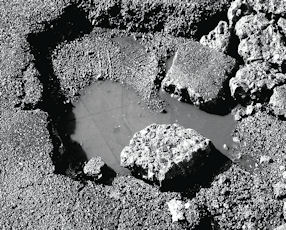There has been so much ink spilled over the proposal by Councilmen Mitchell Englander and Joe Buscaino to put a $3 billion street repair bond on the May 21 ballot that I was hesitant to share my own thoughts. That was until I almost broke my teeth the other day. I’m one of those middle-aged guys people love to mock. I dress up in tight spandex pants, don a weird helmet and jump on my road bike with skinny tires. I say it’s because I want to be healthy, but it’s probably all about vanity, trying to look and feel 20 years younger. Well, vanity costs and does it. My regular route takes me along Forest Lawn Drive in the Toluca Lake area, and what any bike rider or motorist knows is that to traverse that street you really need giant truck tires with bulbous treads. The suspension-wrecking pot holes I’ve seen approach a foot in depth, before some city crew finally comes along and lays down a patch that might last a month or two. And the bike lane is so torn up I need to start wearing an NFL-approved mouth guard. Forest Lawn Drive is one of the worst roads in the city without a doubt, but there are plenty of others. In fact, the city’s Bureau of Street Services has given thousands of street lanes a “D” or “F” rating. But it’s one thing to agree that streets in the San Fernando Valley and other L.A. communities are awful, and another to say we ought to hand City Hall some $3 billion in bond money to repair them. Just the thought makes me nervous. The arguments for the bond issue are simple enough. There simply isn’t enough general fund money to go around, and there is a 60 year backlog in repairs, according to city estimates. Sixty years? How is that even possible? Well, the fact is that Los Angeles didn’t have to worry about its streets for decades as it rapidly grew in the post-war era. It just paved new ones. Now, that growth has slowed and all those streets built in ‘50s, ‘60s and ‘70s are literally crumbling. It’s like everything else about L.A. city government, problems only get fixed when they reach crisis proportions. Viewed from a purely financial perspective, it does make sense to float a bond issue right now. Interest rates are historically low and the economy isn’t going full blast, so for a while at least, the city can borrow on the cheap and get a pretty good deal from its paving contractors and suppliers. But what sticks in everyone’s craw is the idea that somehow we all have to pay extra to fund what should be one of the most essential of all city services: keeping our streets in good enough shape so you can ride on them without later needing to visit the dentist or an auto repair shop. But, of course, if you haven’t figured it out yet, no one at City Hall was socking away money to fix all those streets when the time came. Accounting for depreciation of an asset is apparently a foreign concept at City Hall. And the expense, while small, isn’t trivial, especially for businesses. In order to pay back the bonds, property owners would be charged $34 annually for every $100,000 of assessed value. And that’s not the only new fee being thrown around. There’s also the proposed fee the county wants to stick to residents, businesses and others to stop the storm water runoff that pollutes the region’s rivers and Santa Monica Bay. No one wants to swim or fish in dirty water, but that one would raise about $300 million annually, costing homeowners about $54 a year and big box retailers $11,000. After an outcry, the City Council and Board of Supervisors decided to slow down on both proposals for more discussion. Frankly, I’m not sure what there is to discuss, especially about those street bonds. The city has backed itself into a rutted corner and it simply doesn’t have a lot of options. That has left everyone with an unpalatable choice should the bond measure ever make it to the ballot. Vote “no” and endure years more of bone-rattling rides, or vote “yes” and let City Hall once again stick it to the teeth of residents and businesses. And, I can assure you, that hurts. Laurence Darmiento is editor of the Business Journal. He can be reached at [email protected].
